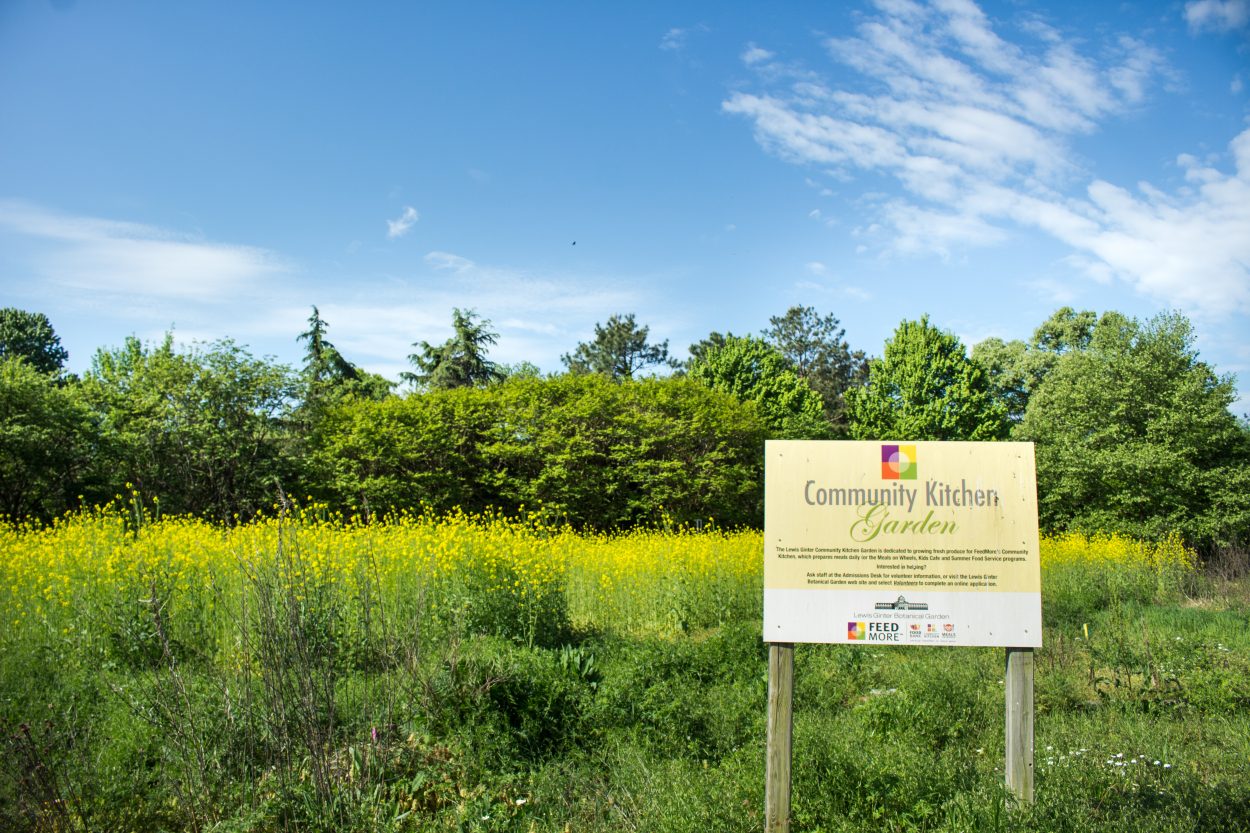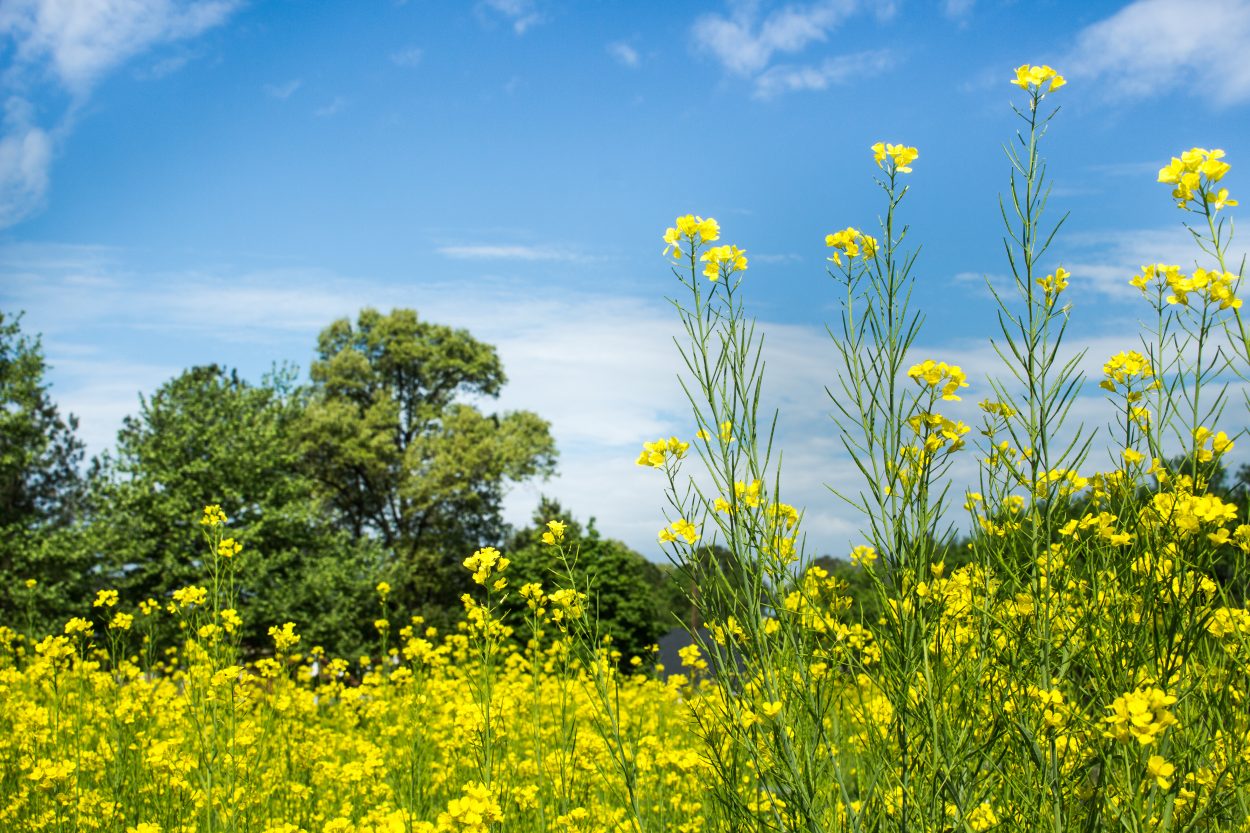Southern Blight & a Natural Solution
How We are Using Mustard Greens to Fight Southern Blight

Mustard greens growing as a cover crop in the Kroger Community Kitchen Garden, part of an experiment to combat southern blight.
Soil is vital and essential because it sustains life. You cannot have a healthy garden without healthy soil. The rear portion of the Kroger Community Kitchen Garden (KCKG) was hit last year with southern blight, a common soil-borne, plant disease. Southern blight affects all parts of the plant and the soil surrounding the plant. Even when the affected plants are gone, southern blight remains in the soil for a long time and continues to infect any susceptible host plant that comes along, making it almost impossible to start new crops without first addressing the underlying cause. While we tried to solarize the soil (covering up the planting beds with clear plastic to heat the soil over time) and kill the fungus that causes southern blight we knew we needed a longer-term solution. That’s where the story of this remarkable project with mustard greens and other cover crops begins.
We reached out to out to Dr. Steven Rideout, director of Virginia Tech’s Eastern Shore Agricultural Research Center , to ask for his expertise on this subject. Rideout’s focus of study is southern blight, and in September 2016 he began to help us to test organic methods that will eliminate this contagious disease. Our objective is to “cleanse” the soil by taking advantage of the natural gas released by certain cover crops, such as mustard greens (Brassica juncea) and rapeseed (Brassica napus), to suppress growth of some soil-borne diseases, including southern blight. The whole process is called biofumigation and is a method that has been scientifically proven to result in a more enhanced microbial biomass in the soil and eventually higher crop yield. It is an organic, sustainable, pre-plant treatment alternative that can improve the quality of the soil by natural processes. Horticulturist Chelsea Mahaffey has been working with Rideout to implement this work at the Garden. “This is more sustainable,” said Mahaffey. “By using organic methods to build the soil quality and limit southern blight, we are maintaining our mission of sustainability to the earth instead of reaching for chemicals.”

Mustard greens are grown as cover crop at the Kroger Community Kitchen Garden as part of a sustainable way to heal the soil after it was infested with southern blight. These mustard green plants will be plowed under the soil and chopped into small pieces and then will be quickly incorporated into the soil to create a biofumigation plot. The plants will act as natural deterrent to weeds, pathogens and diseases.
How it Works:
Mustard greens are a good friend of gardeners. Besides harvesting the leaves and seeds for salads, recipes, prepared mustard and spices, gardeners plant mustard greens as a cover crop. Mustard green plant tissues, from both the roots and the stems, contain a chemical compound and an enzyme in the plant cell that behaves as a soil biofumigant when integrated into the soil, which can suppress nematodes and pathogenic fungi. When the crop is chopped into small pieces and then quickly incorporated and sealed into the soil, the chemical is exposed to the enzyme and it breaks down into a powerful organic chemical compound that serves as a fumigant. The most amazing aspect of this whole process is that the fumigant occurs naturally and is derived from plant. It’s an organic and environmentally-friendly, sustainable treatment for southern blight, which is why we were interested in Virginia Tech’s experiment.
The Plan:
We’ve been working on this treatment plan for one year, but as part of a three-year partnership, we still have two more years to go and a lot to learn. Lewis Ginter Botanical Garden has supplied the area for Virginia Tech team to carry out the research and we’ll take care of planting the cover crops and turning them into the soil at the end of the growing season. Virginia Tech will give us feedback from their observations as we continue this work and refine it based on our results.
For the experiment, the area with southern blight will be divided into three plots. We will plant a different type of cover crop on each plot: the first with mustard greens, the second with rye, and the third with a legume (most likely vetch). “Mustards are known to have biofumigant properties, and we’re testing out the others,” said Mahaffey. “We are looking at the effectiveness to treat southern blight with all three.”
When these plants start to flower with their yellow and purple blooms respectively, it’s a sign that they are ready for the most critical stage of the experiment— to be tilled into the soil and covered with clear plastic to create the biofumigation plot. The objective is to combine solarization and biofumigation into the treatment of soil-borne diseases: the plastic cover will allow solar energy to heat up the soil to create unfavorable conditions for pests, and the crushed plants will transform into a powerful natural compound that can really make a difference. Then we will pump water under the plastic to ‘flood’ the soil, which we hope will suppress the fungus with the anaerobic conditions created by the water. “Anaerobic conditions means without oxygen,” explained Mahaffey. “Like most living things, without oxygen means no life.”
Since there hasn’t been much research on organic practices to counter southern blight, we hope that through this partnership, Lewis Ginter Botanical Garden can become a resource on this topic and give back to the agriculture community through outreach where we share with local farmers and other botanical gardens about a “green” way to heal soil after a bought of southern blight. Who knows, these studies may even show a way that biofumigation can act as a preventative measure. “We hope to find organic means of treating southern blight to give farmers, large and small, and homeowners viable options,” said Mahaffey. “This could give us important options for treating our gardens in sustainable manners.
Meanwhile, we continue to grow produce in the front part of the Kroger Community Kitchen Garden. With a 2,700-pound yield so far, we have been sending large quantities of lettuce, cucumbers, tomatoes, squash, and other produce to FeedMore, which turns them into delicious, nutritious meals for vulnerable populations in Richmond and across Central Virginia. Besides donating to FeedMore, the produce we grow (smaller harvests of radishes and green beans and the like) also go to LAMB’s Basket, a local foodbank serving area residents. Through the KCKG, we give back to the community with fresh, sustainable, and healthy foods that can make a difference.
With Lewis Ginter Botanical Garden’s focus on education and connecting people and plants, we strive to turn as many opportunities as we can into learning experiences. In the past year we’ve spent 1,700 hours in the KCKG educating the community on sustainable practices and agriculture with classes, walk-and-talks, tours, and teaching service learning students. We couldn’t accomplish all this without our dedicated volunteers, who have spent over 1,000 hours watering, weeding, planting and harvesting all of those vegetables. To our wonderful volunteers, if you are reading this blog post, please know that we appreciate you immensely and are deeply grateful for your contribution.